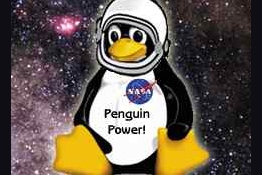A brief history of Linux and the cosmos
IT PRO looks at how free and open source software is helping academics, researchers and scientists gain a better understanding of space and time.

Fifty years ago scientists were restricted to the use of ink and graph paper to assess and compile their data.
The first computer revolution of the seventies and eighties vastly enriched the possibilities. But the second revolution in computer technology that has taken place over the last decade has transformed the work of most scientific establishments.
Broadband and modern storage technologies have made data more available. Data capture has become more refined. Computers can cope with volumes of data that were unimaginable a few short years ago, and can perform iterative calculations that were beyond the realms of possibility even more recently.
The price/performance ratios that were so forbidding in the past have been transformed by the effects of Moore's Law, and the concurrent rise of free and open source software. For most of us this means little more than the notion that office applications are a little less clunky than they used to be. In the world of science it means that the margins of knowledge can be explored a lot further.
A special contribution of free and open source software to the world of academic computing has been the rise of clustering and virtualisation technologies, where any number of instances of Linux often running on commodity hardware boxes are able to replicate the performance of a supercomputer. Such technology emerged from the Beowulf project, which was founded by Donald Becker and Thomas Sterling in 1993 when they began "sketching the outline of a commodity-based cluster system designed as a cost-effective alternative to large supercomputers."
Linux has been attractive to the hardware companies that specialise in HPC (High Performance computing) partly for technical reasons, because of its affordability, modularity, flexibility and accessibility of code, and partly because the licensing has encouraged mutual contributions of code to the common pool. At the last count, Linux was the primary operating system on 426 of the top 500 supercomputers.
A donut-shaped universe
Get the ITPro daily newsletter
Sign up today and you will receive a free copy of our Future Focus 2025 report - the leading guidance on AI, cybersecurity and other IT challenges as per 700+ senior executives
The first Linux-based Beowulf cluster was built by NASA and CESDIS scientists based at the Goddard Space Flight Centre in Greenbelt, Maryland, to address problems associated with the NASA Earth and Space Sciences (ESS) project.
One of the goals of the ESS project was to determine "the applicability of massively parallel computers to the problems faced by the Earth and space sciences community." The Beowulf project is driven by its users, and was the first project of its type, but is being increasingly challenged by COTS implementations of the technology, not all of which are truly open source.
Such technologies have transformed the possibilities for those scientists who dedicate their working lives to running simulations of events at the edge of our universe, and have proved equally beneficial in those specialised commercial environments that require heavy mathematical and/or analytical processing capabilities.
Such a project is the UK COSMOS project led by Stephen Hawking. Hawking is Lucasian professor of mathematics at the University of Cambridge, and is probably the world's most recognisable scientist since Einstein, best known by the layman for penning A Brief History of Time, which is one of those best sellers that many people own but few have read, and for his considerable achievement in the face of adversities that are unimaginable to most of us. He has appeared on recordings by Radiohead and Pink Floyd, played chess with Isaac Newton, Einstein and Mister Data in an episode of Star Trek: The Next Generation, and has exchanged observations with Homer Simpson over a Duff beer in Mo's bar. "Homer", he said to the philosopher of Springfield, "your theory of a donut-shaped universe is intriguing."
-
 Asus ZenScreen Fold OLED MQ17QH review
Asus ZenScreen Fold OLED MQ17QH reviewReviews A stunning foldable 17.3in OLED display – but it's too expensive to be anything more than a thrilling tech demo
By Sasha Muller
-
 How the UK MoJ achieved secure networks for prisons and offices with Palo Alto Networks
How the UK MoJ achieved secure networks for prisons and offices with Palo Alto NetworksCase study Adopting zero trust is a necessity when your own users are trying to launch cyber attacks
By Rory Bathgate
